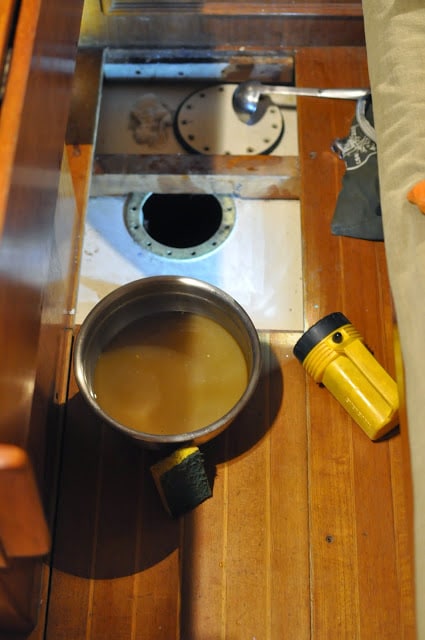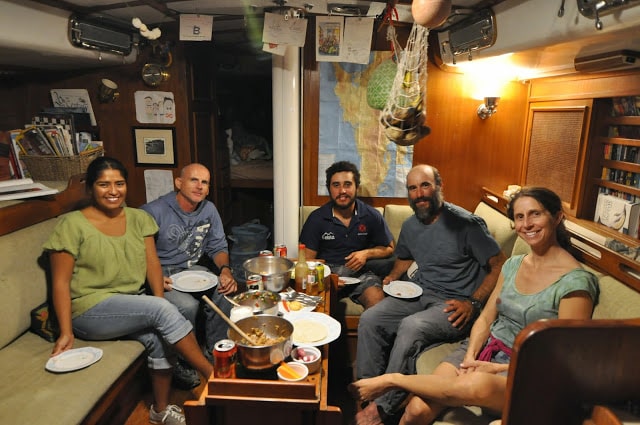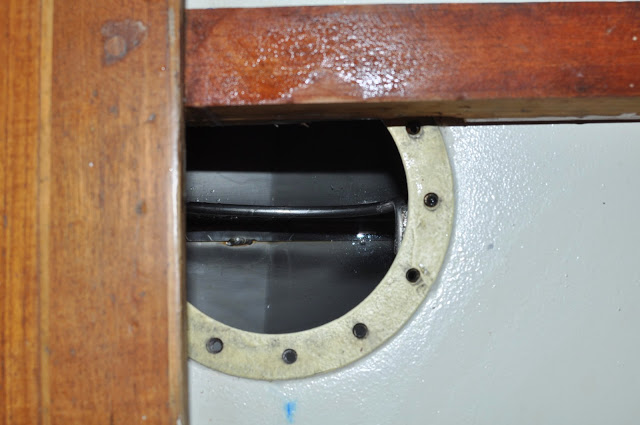
I don’t know how to type the noises that Windy exclaimed from the galley, but I can describe them pretty accurately. It’s precisely and exactly and unequivocally the same noise you or your spouse would make after drawing a glass of water from the tap, taking a big swig, and spitting it out after realizing it was diesel.
I didn’t want it to be true. I didn’t know how it could be true.
I removed the inspection plate on the top of the port tank. The smell of diesel hit immediately. But the fluid in our water tank looked like water. But diesel fuel in Mexico isn’t dyed red as in the States. I dipped a ladle in and examined it. It was water, but with an unmistakable sheen of diesel on the top. I moved to the starboard tank, it was a bit worse.
I looked at Windy, “How in the world?”
“Is it possible you spilled some diesel last time we filled up and it ran into the water tank because the deck cap wasn’t tight?”
“No, I haven’t spilled that much diesel in a long time, and the fuel fill is on the port side, and lower than the water fill on that side.”
“What about during Odile, when we diverted rain water on the deck into the water tank—could there have been something diesel-y up forward?”

It had to be that we took on contaminated water. Since we’ve been north of Loreto, all our water has come from jerry cans ashore, 5-gallon Sparkletts bottles that may or may not be washed between uses. Maybe one was contaminated with clear, Mexican diesel? Seems improbable. I’m always the guy that lugs them aboard and dumps them in through a funnel; I’ve never noticed a diesel smell, not even when handling the cap or the empty bottle afterward.
But both tanks are contaminated, so it would have to have been two contaminated bottles. But the tanks are connected by a common vent line.
Then I thought of an interface between our fuel and water tanks: the Heart Tank Tender. Small air hoses from a common gauge go to both the water and fuel tanks. I unscrewed the unit from the wall and quickly dismissed it as a possible source of contamination. Not only do the independent hoses travel six vertical feet from the tanks to the gauge, but the air that is pumped through them only goes one way and there were no signs of liquid in any of them.

For the last several days, I’ve been on my hands and knees, emptying the stainless steel tanks dry with a sponge, cleaning every square inch of them I can reach with rubbing alcohol (I read to do this online) and repeatedly flushing them with water and vinegar and with water and dish soap and with water and baking soda (trying everything I’ve read online).
Things are better, but not yet great. Our galley foot pump failed a couple weeks ago, so we were using pressure water when the contamination was discovered. This means that a much larger system is exposed: much more hose, the pressure pump, the lines to the head, and the water heater.
I don’t know how much more flushing is in our future, but I’ll let you know.
–MR
In our twenties, we traded our boat for a house and our freedom for careers. In our thirties, we slumbered through the American dream. In our forties, we woke and traded our house for a boat and our careers for freedom. And here we are. Follow along at http://www.logofdelviento.blogspot.com








